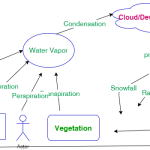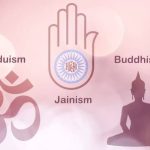Table of Contents
Important Drainage Patterns of India:
- Dendritic : Drainage Pattern resembling branches of tree eg : rivers of N India
- Radial : Rivers orig from hill & flow in all directions eg Amarkantak Range
- Trellis : When Primary Tribut flow // to each other & Secondary Tributs join them at _|_ angles
- Centripetal : Rivers discharge their waters from all directions in a lake / depression
- River Basin : Catchments area of large Rivers ; Watershed : Catchment of small rivulets & rills ; Diff : Area ( Watershed < River Basin)
- Why are River Basins / Watersheds accepted as most apt micro, meso or macro planning regions ?Ans ) River Basins & Watersheds are marked by unity ; what happens in one part directly affects the other part or unit
- Indian Drainage sytem div on basis of discharge of water : (1) Arabian Sea Drainage ( 77% ) (2) Bay of Bengal Drainage ( 23% )
—> Separated from each other by Delhi Ridge , Aravalis & Sahyadris
- On Basis of size of watershed
- Major River Basins : > 20,000 sq km of Catchment Area ( 14 ) ( Ganga Brahmaputra Krishna Narmada Tapi Mahi Sabarmati )
- Medium River Basins : 2,000 – 20,000 sq km of Catchment Area ( 44 ) ( Kalindi, Periyar, Meghna )
- Minor River Basins : < 2000 sq km Catchment Are
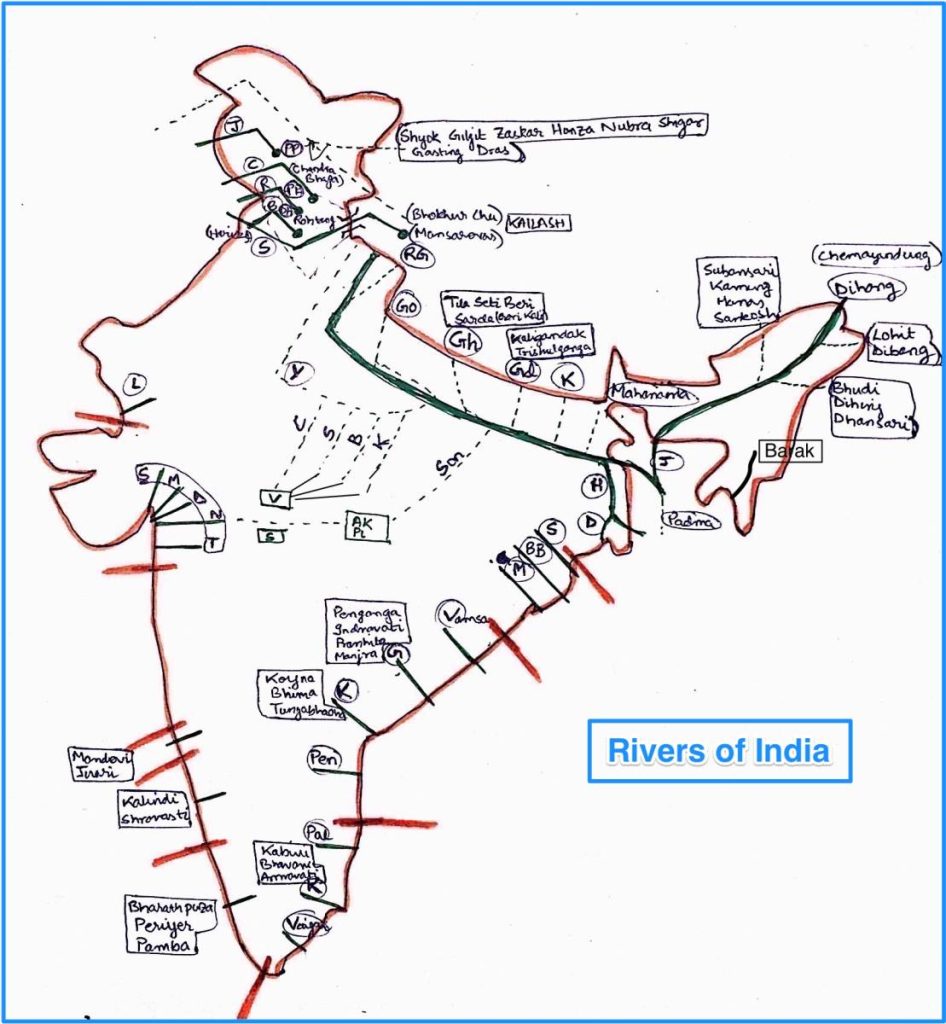
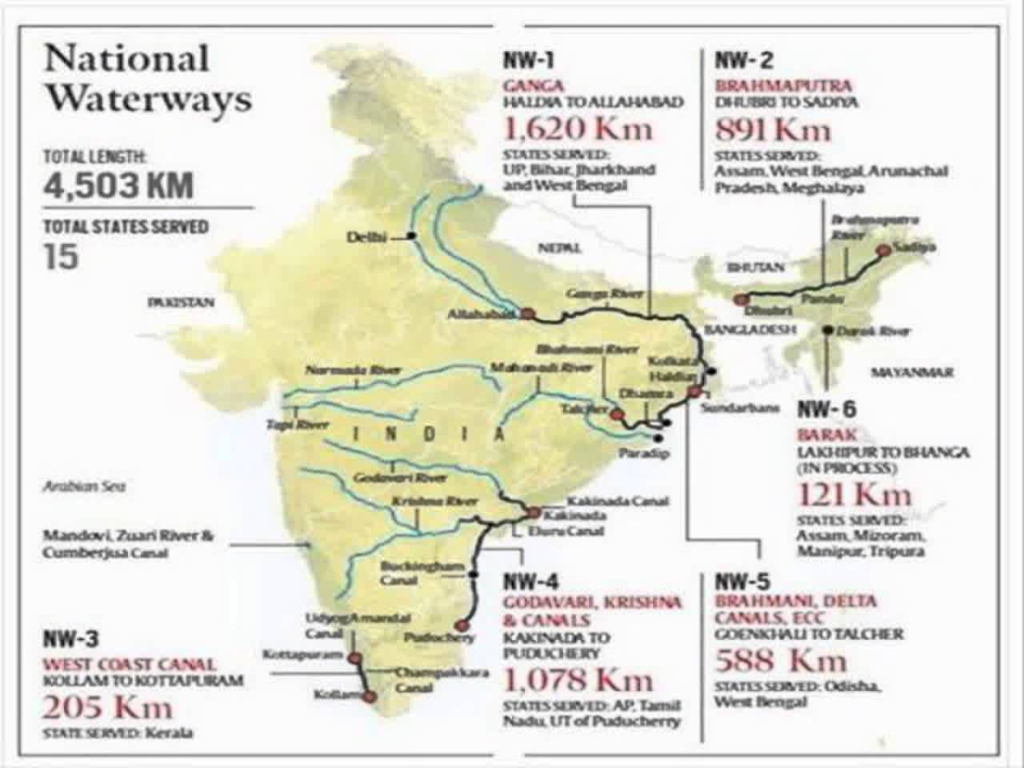
Himalayan Drainage System
- Rivers are perennial ; fed by melting of snow & precipitation —> form V shaped valleys, deep gorges, rapids & waterfalls
- When entering plains Rivers form Depositional Features : flat valleys, ox-bow lakes, flood plains, braided channels & deltas
In Himalayas : courses of R : tortous ; In plains: display strong meandering tendency & shift courses freq
—> R.Kosi = Sorrow of Bihar, as brings huge amt of sediments from upper reaches ; course gets blocked & conseq R changes course
- Evolution of Himalayan Drainage system :
- One mighty river Indo-Brahma traversed entire Longit extent of ∆H & finally discharged in Gulf of Sind 5-24 mil ago Miocene period
- Reasons for dis-memberment of Indo-Brahma :
- Pleistocene upheaval in W ∆H, includ uplift of Potwar Plat (Delhi Ridge) : acted as water divide betw Indus & Ganga
- Down thrusting of Malda gap betw Rajamahal & Meghalaya Plat during Mid-Pleistocene, diverted G&B towards Bay of B
INDUS Drainage SYSTEM :
- a.k.a. Sindhu ; Area : 11,65,000 sq km Length : 2,880 km ( In India Area : 321,289 sq km Length : 1,114 km)
- Orig : Bokhar Chu glacier Tibet, Kailash Range ( 4,164 m )
- In Tibet a.k.a. ‘Singi Khamban’ or “Lion’s Mouth”
- Flowing in NW direction betw Ladakh & Zaskar —> cuts across Ladakh —> forms Gorge near Gilgit, J&K —> enters Pak in Dardistan
- Emerges out of hills near Attock
- Indus receives Panjnad (Name given to the 5 rivers of Punjab : J > C > R > B > S ) above Mithankot
- Indus flows in India only through ‘Leh’ district in J&K
|
Indus : |
Shyok + Gilgit + Zaskar + Hunza + Nubra + Shigar + Gasting + Dras |
Khurram + Tochi + Gomal + Viboa + Sagar (all orig in Sulaiman Range) |
|
1) Jhelum : |
|
|
2) Chenab : |
|
|
3) Ravi : |
|
|
4) Beas : |
|
|
5) Sutlej : |
|
GANGA Drainage SYSTEM :
- Rises in Gangotri near Gaumukh (3900 m) in Uttarkashi, UK . Here known as Bhagirathi
- Devprayag : Bhagirathi meets Alaknanda ; Henceforth known as Ganga
- Alaknanda ( + DhauliGanga , viz meet at Vishnu Prayag ) , has source in Badrinath
- Other Tributs of Alaknanda : Pindar joins at Karna Prayag ; Mandakini joins at Rudra Prayag
- Ganga enters plains at Haridwar ; Splits much later into 2 distribut : Bhagirathi + Hugli
- Length 2,525 km (UK , UP , Bihar, WB)
- Major Right Bank Tribut : Son
- Imp Left Bank Tribut :
Ramganga, Gomati, Ghaghara, Gandak, Kosi, Mahananda

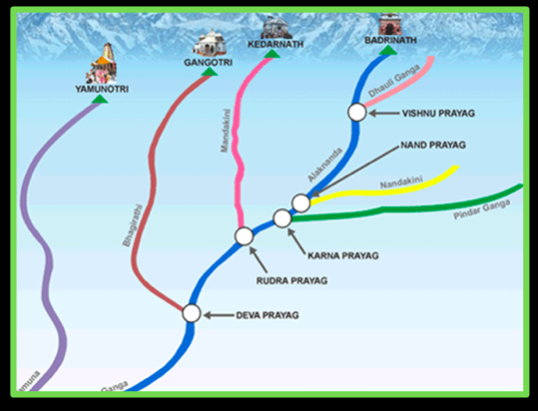
|
1) Ramganga : |
|
|
2) Ghaghara : |
|
|
3) Gandak : |
|
|
4) Kosi : |
|
|
5) Mahananda : |
|
|
1) Yamuna : |
Left Bank tribut : Hindan, Rind , Sengar, Varuna
|
|
2) Son : |
|
|
3) Damodar : |
|

BRAHMAPUTRA Drainage SYSTEM :
- Orig : Chemayungdung glaciers of Kailash range near Mansarovar
- Travels E (1,200 km) in dry flat S Tibet , a.k.a. Tsangpo (the purifier) (Rango Tsang-po is major R Bank Tribut )
- Comes out of deep gorge in C∆H near Namcha Barwa —> enters foothills as Dihang —> enters India W of Sadiya town in AP—> Flowing SW receives main L Bank tributs Dibang & Lohit —> thereafter known as Brahmaputra
|
Brahmaputra : |
Dibang + Lohit + Burhi + Dihing + Dhansari |
Subansiri + Kameng + Manas + Sankosh |
- In Bangladesh, Tista joins it on its R Bank —> henceforth known as Jamuna —> Finally merges with Ganga —> Hence called Padma
- Brahmaputra well known for floods, channel shifting & erosion : most tributs bring large sediments owing to heavy RF in catchment area
Peninsular Drainage System
- Older than ∆H drainage system : evident from broad, largely graded shallow valleys & maturity of rivers
- W Ghats acts as water divide betw 2 oceans
- Penin R char by fixed course, absence of meanders & non-perennial flow of water ; Exception : Narmada & Tapi flow through Rift valley
- 3 MAJOR Geological events of Past viz shaped Penin Drainage systems :
- Subsidence of W flank of Penin —> submergence below sea (Tertiary Period ) —> disturbing symmetrical plan of river on either side of original Watershed
- Subsidence & conseq Trough Faulting of N flank of Penin —> Narmada & Tapi flow in trough faults & fill orig cracks with deritus materials . Hence lack of Alluvial & deltaic deposits in N & T
- Slight tilting of Penin from NW to SE dir gave orientation of entire drainage sys towards Bay of B
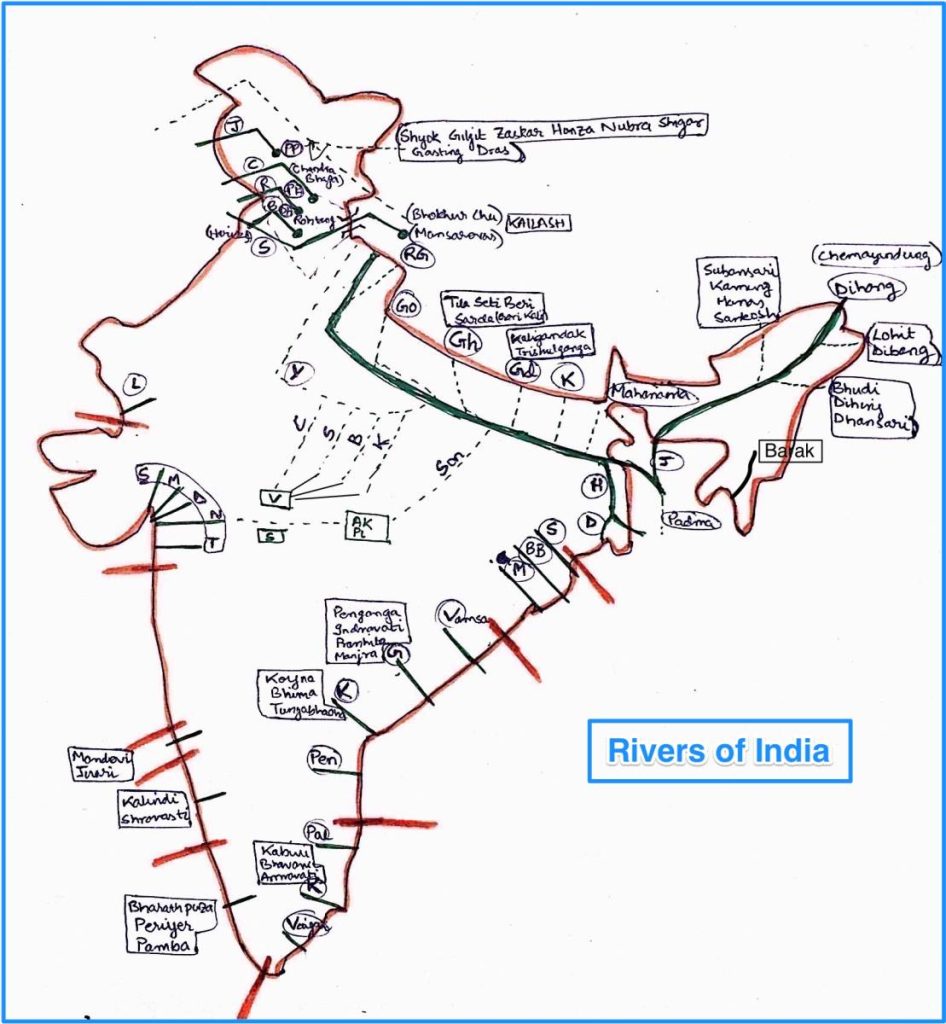
EAST : Peninsular Drainage System
|
1) Subarnarekha : |
Bengal-Odisha |
|
2) Baitarni + Brahmini : |
(Odisha) |
|
3) Mahanadi : |
Orig : Raipur, Chattisgarh & runs through Odisha |
|
4) Vamsadhara : |
AP |
|
5) Godavari : |
|
|
6) Krishna : |
|
|
7) Penner : |
AP |
|
8) Palar : |
TN |
|
9) Kaveri : |
|
|
10) Vaigai |
TN |
WEST : Peninsular Drainage System
|
0) Luni : |
|
|
1) Sabarmati & Mahi : |
Gujarat |
|
2) Dhadhar : |
Gujarat |
|
3) Narmada : |
|
|
4) Tapi : |
Orig : Multai in Betul District of MP |
|
5) Mandovi + Juari |
Goa |
|
6) Kalinadi Sharavasti |
Karnataka |
|
7) Bharathpuza Periyar Pamba |
Kerala |
Himalayan River Vs Peninsular River
|
ASPECT |
HIMALAYAN Rivers |
PENIN Rivers |
|
Place of Origin |
∆H covered with Glaciers |
Penin Plat & C. Highlands |
|
Nature of flow |
Perennial ( receive from Glacier & RF ) |
Seasonal ( Dep on Monsoon RF ) |
|
Type of Drainage |
Antecedent —> dendritic pattern in plains |
Super imposed —>Trellis, Radial & Rect |
|
Nature of River |
Long course flowing through rugged mtns —> Headward erosion & River capturing In Plains, meandering & shifting of course Meandering is a mature/old age phenomenon |
Smaller, fixed course with well adjusted Valleys Ox bow lakes (Old Stage) |
|
Catchment Area |
V. Large Basins |
Relatively smaller Basin |
|
Age of River |
Young, youthful, active & deepening in Valleys |
Old Rivers with graded profile, have almost reached their base levels |



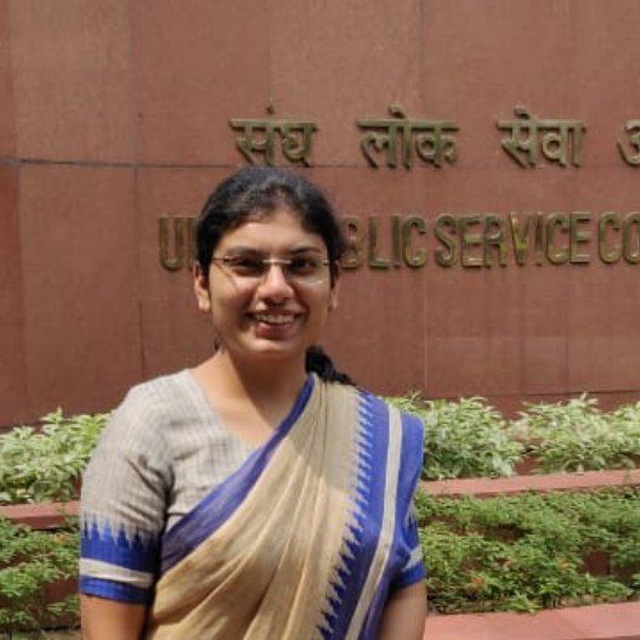


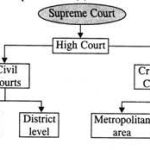



![UPSC CSE Topper Mains Answer [Part 3] images-2023-06-17T192506.595](https://iasbio.com/wp-content/uploads/2023/06/images-2023-06-17T192506.595-150x150.jpeg)




